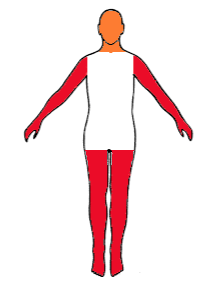Rule book
Nämä säännöt ovat vuoden 2025 pehmomiekkailun ja sotahuuto-tapahtuman viralliset säännöt. Mahdollisista sääntömuutoksista tullaan tiedottamaan tapahtuman lähestyessä. Vuoden pääasiallinen päivitys tapahtui 31.12.2024.
The battle rules are simple. A hit to a limb renders the limb unusable and a hit to the torso or head results in death. A new hit to an already injured limb also results in death. Losing two hands or two feet also results in death.
The areas of the hit locations will be made clear in the following diagram. More detailed verbal definitions can be found in the attachments of the detailed battle rules.

A hit will be counted as any contact made by the weapon's blade or active part (such as the tip of a war hammer) that reaches the opponent as a result of an attack. Hitting clearly separate clothing from the body is not counted as a hit. It's courteous to make it clear to the attacker whether or not the strike hit or not. Every hit on the fighter is counted regardless of how light it is.
Each participant must keep track of the hits they have received. If someone does not track the hits and wont register them, this can be reported to the fighter or the leader of their team after the scenario. Breaking the rules might result in point deductions. In uncertain situations, it is best for everyone to take an uncertain hit courteously, which will lead to the least amount of complaints.
Contact
It is allowed to grab the opponent's weapon, but not the blade of a blade weapon.
Physical contact between participants is allowed. However, holding on to the opponent is prohibited, as well as aggressive pushing, wrestling, or other physical grappling. No technique should lead to any kind of locks or submission holds.
It is allowed to use the shield to make contact with the opponent by pushing. The shield cannot be used to strike and should not be used to knock down opponents. Uncontrolled or knockdown-oriented charging is prohibited. Polearms can be used to push shields and weapons, but they cannot be used for wrestling. Do not perform strikes with parts of the weapon that are not padded.
If you get to hit an opponent from behind, be careful and don’t use excessive force. Strikes to the neck, back of the head and kidney area should be avoided.
Armour
A piece of armour that is made according to the armour rules prevents one hit from the area the armour covers. Armour does not regenerate during scenarios. If the rules of the scenario have respawns, the armour regenerates when the player respawns.
Death
When a fighter is dead, they must immediately stop fighting and get out of contact. Dead fighters should not speak or give any kind of signals. They can only indicate that they are dead verbally, by raising their hand or by putting their weapon upside down.
Some scenarios have rules for respawning. Respawn rules will be announced in the scenario briefing.
STOP-huuto
Mikäli taistelija tai valvoja huomaa taistelutoiminnan aikaisen vaaratilanteen, tulee hänen huutaa “STOP! STOP! STOP!”.
Stop-komento keskeyttää välittömästi kaiken taistelutoiminnan. Komennon kuullessaan taistelijan on välittömästi lopetettava kaikki liike, tämän jälkeen toistettava Stop-komento ja käytävä polvelle odottamaan taistelun jatkumista. Valvojat ilmoittavat skenaarion jatkumisesta.
Taistelijoiden tulee välttää taistelemasta selvästi loukkaantuneiden henkilöiden läheisyydessä. Loukkaantuneita tulee aina tarvittaessa auttaa ensiapupisteelle riippumatta tilanteesta.